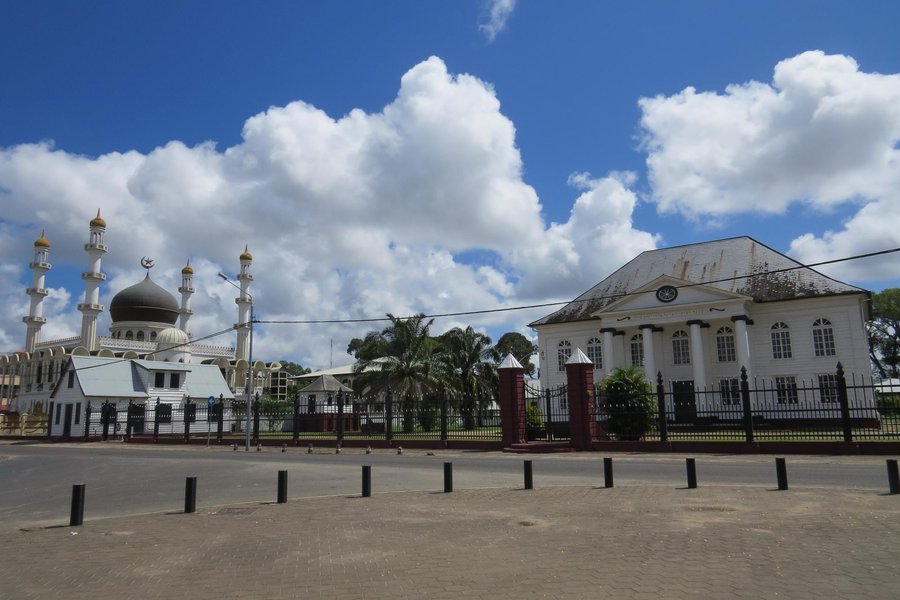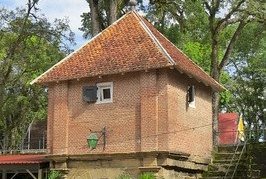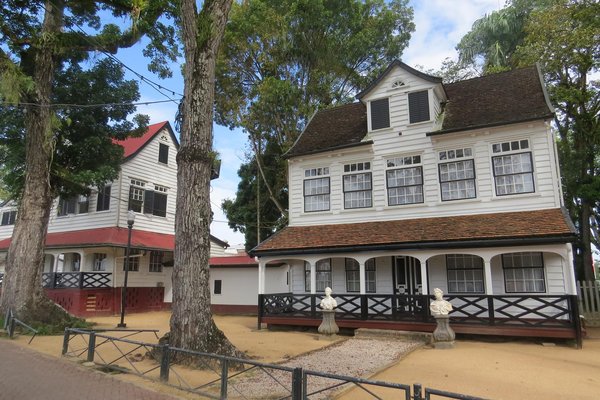Suriname
Paramaribo
The Historic Inner City of Paramaribo shows the fusion of Dutch colonial architecture and indigenous cultural elements
The city was built in 1683 and further extended across marshy land in the 18th century. Most of its residences are built entirely in wood and are very vulnerable to fires. Notable public buildings include Fort Zeelandia, the Presidential Palace, the neoclassical Reformed Church and the gothic revival Roman Catholic Cathedral.
Community Perspective: the relatively small core zone is located along the left bank of the Suriname River, centered around the street called “Waterkant”. It’s best explored on foot, and you’ll find a number of high-quality colonial buildings that are unique in the Caribbean world.
Site Info
Official Information
- Full Name
- Historic Inner City of Paramaribo (ID: 940)
- Country
- Suriname
- Status
-
Inscribed 2002
Site history
History of Paramaribo
- 2002: Inscribed
- Inscribed
- 1999: Deferred
- Bureau - for imp of various recommendations
- Type
- Cultural
- Criteria
- ii
- iv
Links
- UNESCO
- whc.unesco.org
- Official
-
- suriname-heritage-guide.com — Heritage Suriname
- Related
-
- surinaamsmuseum.net — Suriname Museum at Fort Zeelandia
All Links
UNESCO.org
- whc.unesco.org — whc.unesco.org/
Official Website
- suriname-heritage-guide.com — Heritage Suriname
Related Resources
- surinaamsmuseum.net — Suriname Museum at Fort Zeelandia
News Article
- April 10, 2024 iadb.org — Suriname Receives a US$30 Million Loan to Revitalize Paramaribo’s Cultural Heritage
- Nov. 5, 2013 jamaicaobserver.com — UNESCO threatens to remove Paramaribo from list
Community Information
- Community Category
- Urban landscape: Colonial
Travel Information
Recent Connections
-
In the Israel Museum
Contents of the Former Tzedek ve-Shalom… -
Star fort
Fort ZeelandiaSee en.wikipedia.org
-
Atlantic Ocean
At the Suriname River, which flows into…
Connections of Paramaribo
- Geography
-
-
Situated in one of the SIDS
Suriname 2002 -
Located in a Capital City
Paramaribo (Capital of Surinam) -
Atlantic Ocean
At the Suriname River, which flows into the Atlantic Ocean a few kms downstream
-
- Trivia
-
-
Built or owned by British
Fort Zeelandia was founded in 1651 by the British, and named Fort Willoughby -
Built or owned by Dutch
Dutch colonial public buildings, such as Fort Zeelandia (1667), the Presidential Palace (1730), the Ministry of Finance (1841), the Reformed Church (1837), and the Roman Catholic Cathedral (1885) -
In the Israel Museum
Contents of the Former Tzedek ve-Shalom SynagogueSee www.imj.org.il
-
- History
-
-
Fusion
"gradual fusion of European architecture and construction techniques with indigenous South America materials and crafts to create a new architectural idiom" -
Assassinations
(Courtyard of Fort Zeelandia) 15 Opposition leaders ("Decembermoorden" Dec 8 1982) -
WIC
Owned by the WIC from 1682, and used for the trade in coffee, sugar and slaves
-
- Architecture
-
-
Gothic Revival
Roman Catholic cathedral -
Wooden architecture
-
Neoclassical architecture
the neoclassical Reformed Church is built from brick (unesco website) -
Brick architecture
Most of the buildings are made out of wood, except for the Ministry of Finance and a few others -
Octagons
Reformed ChurchSee nl.wikipedia.org
-
Star fort
Fort ZeelandiaSee en.wikipedia.org
-
- Religion and Belief
-
-
Jewish religion and culture
Neve Shalom Synagogue 1665 -
Cathedrals
Roman Catholic Cathedral St. Petrus en Paulus -
Protestantism
Reformed Church (1837)
-
- Constructions
-
-
Prison
Fort Zeelandia served as prison -
Sites of Parliament
National Assembly of Suriname: situated in the former park house at the Independence Square in Paramaribo, after a fire destroyed the old building of representation on 1 August 1996See en.wikipedia.org
-
Historic Cinemas
"Tower Bioscoop" (1948) Heerenstraat (said in 2006 to be partly in use as offices with the auditorium only occasionally used) -
Clock Tower
At the Ministry of Finance (1839)See nl.wikipedia.org
-
- WHS on Other Lists
-
-
U.S. Ambassadors Fund
Preservation of Traditional Culture and Music (2006), Preservation of 18th- and 19th-Century Moravian Mission Records (2005)
-
- Timeline
-
-
Built in the 17th century
Paramaribo began when Fort Zeelandia was built in 1667 on a promontory on the left bank of the Suriname River. In 1683 Van Sommelsdijck, the first governor and joint owner of the colony, laid out a planned town.
-
News
- iadb.org 04/10/2024
- Suriname Receives a US$30 Million …
- jamaicaobserver.com 11/05/2013
- UNESCO threatens to remove Paramar…
Recent Visitors
Visitors of Paramaribo
- Adrian Turtschi
- Alejandro Lau
- Ali Zingstra
- A. Mehmet Haksever
- Ammon Watkins
- Ana
- Artur Anuszewski
- Ask Gudmundsen
- Bill Maurmann
- Bram de Bruin
- Carlos Sotelo
- Christoph
- Chunsian01
- Els Slots
- Erik G
- Eva Kisgyorgy
- Femke Roos
- Fernweh
- Geert Luiken
- Gernot
- Harry Mitsidis
- Janos
- João Aender
- Jon Opol
- Loic Pedras
- Luis Filipe Gaspar
- Marlies van Wolfswinkel
- Martin
- Michael Ayers
- Michael Novins
- Mikko
- Patrik
- Philipp Leu
- Pink Bunny
- Roger Ourset
- Solivagant
- Tevity
- Thomas Buechler
- Thomas van der Walt
- Timothy C Easton
- Vernon Prieto
- Zoë Sheng
Community Reviews
Show full reviews
We found the old timber colonial buildings a very interesting architecture. Several buildings have been beautifully restored, but some buildings are in process of strong deterioration, such as some government buildings (e.g. the Ministry of Housing!!!, the police HQ). Some good guide books are available in local bookshops, but also guided tours are available. Unfortunately reinforced concrete and cement block buildings are being developed. There are signs that the technology of climatologically suitable timber constructions are being revived, using better construction methods, thermal insulation and soft-timber conservation methods. Pity.
Keep reading 0 comments
Paramaribo is a large, sprawling city. I explored it on foot during my first day here in Suriname. As my guesthouse was located on the outskirts of town, I had to walk quite a bit in the constant dry heat. There are a lot of cars and buses on the roads, it all seemed relatively prosperous and lively. It took me about 40 minutes to reach the “Waterkant”, the stretch near the Suriname River where the area with the best quality colonial buildings starts. Along the way, in the commercial city center, there are some old wooden buildings too, but these are dilapidated and almost hidden among the gold jewellers, the casinos and the Chinese supermarkets.
The historic core zone is also blessed with quieter, leafy streets. The wooden mansions, all white, are of a size that could only have belonged to wealthy colonials or government buildings. Here also lies Fort Zeelandia – a very small fortress in the typical Dutch style. The surrounding officers' houses in my opinion are the greatest examples of the wooden architecture of Paramaribo. This whole area is in a brilliant state of conservation by the way.
I was the first to enter Fort Zeelandia that day. They had no change available yet to break my 50 Suri dollar bill, but the friendly man on guard waved me in and said I could pay later when I left. The inner court of the Fort looks unbelievably Dutch, thanks to the use of red …
Keep reading 0 comments
Paramaribo is one of the most beautiful and excited cities in south america. It has a great history. Which can be seen by the streets and houses. Its a small city, but with great people from different origines (hindi, creool, javaans, chinees, indiaan, bosneger, europeanen). Further more it has wonderfull jungle areas and sightseeing places, like new nickerie. The food/drinks are great.
I think everybody should have visit Suriname for one time it his/hers life. The climate is warm with a cool breeze. The people are great and welcomes everybody who visits the country. The history of Suriname and Paramaribo is nice and colorfull. It tells about the dutch, britisch, spanisch and portugeese influens during the past centuries. Wonderfull and nice houses, churches, buildings, etc. Go and see for your self. Greetings,
Keep reading 0 comments
